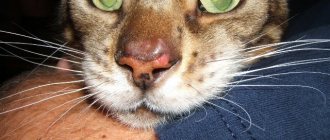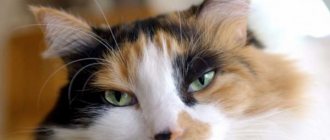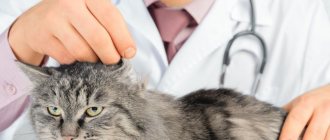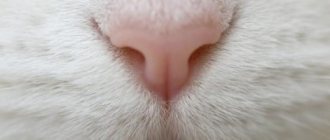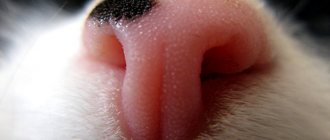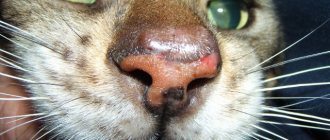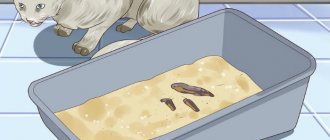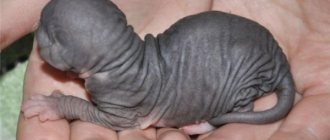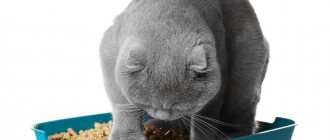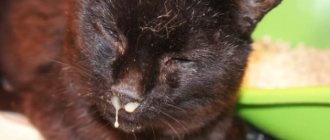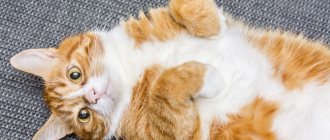Structure of a cat's nose
The cat's nose is not very different in structure from the noses of other mammals. He has:
- 2 nostrils;
- two nasal passages called choanae;
- cavities;
- labyrinth of lattice shells.
The nose is devoid of fur and has a unique skin pattern, akin to human fingerprints.
The skin pattern on a cat's nose is strictly individual.
The cat's nose has an interesting assistant - Jacobson's organ (vomeronasal organ). It is located in the animal's mouth, on the palate. Consists of two small, liquid-filled sacs. Using the palatal canals, it connects the cat's nasal cavity and mouth.
Jacobson's organ is located on the upper palate behind the front incisors.
When a cat needs a more concentrated amount of odor molecules, it uses this organ. From the outside it seems that the cat is smiling, its mouth is slightly open, its nose is wrinkled, the cat is sucking in a large portion of air. This process is called flehmen (flahmen-smile). Cats often use it during courtship. Cats use it too. But kittens begin to resort to his help at the age of 2 months. Some other mammals also have this organ.
Fleemen is the name of a characteristic movement of the lips in cats associated with the capture of volatile aromatic substances, in particular pheromones, into the area of the receptive organ - the vomeronasal organ.
In humans, the vomeronasal organ is also formed during fetal development, but then undergoes regression. But this does not happen for all people, as military surgeons proved back in the 18th century. Research concerning the Jacobson's organ in humans is still ongoing, scientists are only at the very beginning of the journey.
Normal condition
It is well known that a cat’s nose should be moist, cool, and clean if we are talking about a healthy animal. Monitoring your cat's well-being is not difficult at all. You can always touch the muzzle and inspect the external organs. Appearance of a healthy cat's nose:
- The color is uniform (may change as it grows older).
- The skin is smooth, barely glittering from moisture.
- There is no damage to the nasal planum.
- The nostrils are free, without discharge.
- The fur around the nose is clean and fluffy.
Cat's nose
By the way! The “pattern” of a cat’s noselobes is unique. Its uniqueness is comparable to human fingerprints.
Functions of a cat's nose
The cat's nose has truly amazing properties.
Table: comparative characteristics of the sensitivity of smell
| View | Area of the olfactory epithelium | Number of olfactory receptors | Sensitivity |
| Human | 2–4 cm2 | ~5 million | Sample for comparison |
| Cat | 20 cm2 | ~200 million | 20 times better than a human |
| Dog | 170 cm2 | ~220 million | 50–1000 times better than a human |
Thus, it is clear that a cat’s nose, although weaker than a dog’s, is much more sensitive than a human’s. A cat is able not only to recognize odors hidden from humans, but also to build a complete picture of the surrounding space. Cats, unlike dogs, do not use their sense of smell to search for prey or stalk. She just doesn't need it. But for orientation in space, when communicating with relatives and people, and determining the suitability of food, it uses it with success.
This is why you should not wash your cat's bowls using chemicals. The pet will smell the substance for a very long time, and accordingly, this can lead to refusal of food. You should also be careful when cleaning your cat's litter box. It is enough to wash it with hot water in a timely manner, since high temperature destroys ammonia molecules, and the smell ceases to exist for humans. But not for a cat.
Many owners have learned to determine the quality of meat products by offering them to their cat. The fact is that the animal, carefully sniffing the food offered, easily determines its suitability for consumption. And the sausage, stuffed with preservatives and other “chemicals”, will remain untouched.
Cats love certain smells. Manufacturers know this and flavor their feed. This is what explains the passion of animals for dry food or canned food. And this is why pets so easily switch to this diet and refuse regular food.
Manufacturers of cheap dry food flavor them to make the product attractive to cats.
But the smell of orange or mothballs disgusts pets. These scents are used as repellents in all sorts of products designed to wean a cat off something.
Cats also do not like the smell of garlic and onions. At home, these finely grated vegetables can be placed in plates where the presence of cats is undesirable.
In addition to olfactory functions, a cat's nose is also intended for:
- warming and humidifying inhaled air;
- determining food temperature.
A cat is able to retain molecules of certain aromas in the nasal labyrinth in order to use the smell for its own purposes longer. Kittens use this technique with success. Being blind, they not only find the mother, but also distinguish the cat's nipples.
A newborn kitten finds its mother and her nipples solely by smell
Treatment
Even an experienced breeder will not be able to diagnose a dangerous disease just because the cat’s nose has become hot and dry. It is easy to make a mistake in diagnosis even based on a combination of external signs.
The main thing that the owner of a sick animal should do before contacting a veterinarian is to measure the temperature of his pet. At home, its indicator will be more accurate than in the clinic, where the cat usually experiences additional stress, aggravating the patient’s condition.
What you can handle on your own
If nothing serious has happened, the owner can bring things back to normal himself - there are a lot of similar situations, we will describe only the most common ones.
Nasal contamination
If you forget to regularly clean your pet's nose, heavy contamination will make it difficult for him to breathe and interfere with the production of physiological lubrication. As a result, thermoregulation will be disrupted and the nose will become hot. A dirty nose must be carefully cleaned both outside and inside so as not to damage sensitive tissues. After 15–20 minutes, all parameters of his condition are normalized.
Clean your cat's nose thoroughly and it will immediately feel better.
Sunburn
All cats love warmth and can happily doze off “in the sun.” But a long stay under the scorching rays of the sun will definitely not do them any good. Incidents of burns are more common than one might think, especially in animals with delicate pink noses.
A cat who has received a sunburn will have a red, hot, and sore nose. After some time, the skin on it will become rough, rough and dry. Immediately use anti-burn, moisturizing and anti-inflammatory agents - for example, Panthenol. Apply the medicine carefully so that it does not get into the nostrils, and repeat the procedure more often as the product is absorbed.
Cats with pink noses are more likely to get burned than others.
Allergy to chemicals
Many animals, like people, are prone to allergies. Remember this when cleaning your apartment - poorly washed cleansers can cause considerable harm to your inquisitive cat, who literally pokes his nose into every corner of the house.
You are cleaning with gloves, and perhaps even a respirator, but the cat’s nose is not protected by anything... Aggressive chemicals entering the respiratory system can cause severe allergies in the animal, and the nose will be the first to react: its temperature will increase, discharge or rashes will appear.
Chemicals can cause allergies in cats
It is urgent to carry out repeated wet cleaning, wash off with clean water all the remaining chemicals that provoke irritation and allergic reactions. At the same time, consult your veterinarian about which antihistamines and in what dosage should be given to your cat.
In what cases is the help of a veterinarian required?
Do not self-medicate and do not waste time; at the slightest suspicion that the animal is sick, contact a veterinary clinic. Only a doctor can conduct all the necessary studies to clarify the picture of the disease, make an accurate diagnosis and prescribe effective treatment.
A signal for an urgent visit to the veterinarian can be either the fact that the cat’s nose remains hot and dry for more than half an hour for no apparent reason, or additional alarming symptoms that were described above. Timely seeking medical help can save your pet's life - for example, in case of poisoning.
The most common condition that causes a cat's nose to become hot is rhinotracheitis, a viral infection of the upper respiratory tract. An infected cat is in a depressed state, and its nose soon becomes wet from being dry, discharge appears from it, from the eyes, from the mouth... the nose turns red, becomes covered with wounds and crusts. It is difficult for a cat to breathe and eat; the digestive and nervous systems suffer. If this disease is left untreated or treated incorrectly, the cat can suffer serious complications and even die.
Video: what to do if your cat has a cold
What should the nose of healthy cats and kittens look like?
Normally, the nose of a healthy animal has a regular, clear shape. There should be no curvature of the nostrils, the right and left parts should be symmetrical.
Wet or dry
A healthy pet's nose is usually moist. Moisture helps you sense and retain odors better. To better identify them, the cat licks its nose to moisten it more. This technique is also used by other predators.
A cat wets its nose by licking to better distinguish odors.
As a rule, a wet nose occurs in a cat that is awake and in a calm state. An animal that has just woken up will have a dry nose. But this should not cause concern, because during sleep the nose is not particularly needed. But if the nose remains dry within half an hour of being awake, then this is a direct indication that the pet is not feeling well. Of course, you shouldn’t panic right away; you should pay attention to other signs that may confirm fears of poor health: lethargy, digestive disorders, refusal to eat.
Another point worth considering is the breed of the pet. Thus, representatives of the Bengal breed have a dry nose. And this is not considered a disease or deviation from the norm.
Warm or cold
Normally, a wet nose should be cool. This is a natural physiological process. A dry nose will be, accordingly, warm. But again, you should pay attention to what the cat was doing. If the pet has just woken up, the nose is dry and warm. After active physical activity, the nose will be moist, but warm or even hot.
A awake pet's nose should be wet and cold.
Video: hot dry nose - is it dangerous?
How to examine a cat's nasal cavity
This is done exclusively by a veterinarian who uses special testing tools. The examination is carried out only under anesthesia so that the cat does not feel pain or discomfort.
Also, to measure temperature, the doctor inserts a thermometer into the anus - this is how the pet’s body temperature is measured.
The doctor will carry out procedures, identify important deviations and prescribe the correct treatment. Some procedures will have to be carried out exclusively with a doctor, some the veterinarian will show you, and you will treat the cat at home.
The help of a doctor will never hurt, because he will correctly diagnose and prescribe the right medications.
Signs of an unhealthy nose
Animals cannot tell their owner that they feel bad. And only an attentive owner will pay attention to changes in the animal’s behavior. At the same time, a pet’s nose can tell a lot.
- A hot and dry nose is one of the very first signs of the disease. This is how the body signals an increase in the cat’s body temperature. On a hot surface, moisture evaporates intensely, and the nose becomes dry.
- Any nasal discharge that does not stop for a short period of time is a clear sign of the disease:
- Clear discharge coupled with sneezing may indicate allergic reactions or viral diseases.
- Purulent discharge is bacterial in nature.
- Bleeding can indicate both injuries to the nose itself and more serious injuries to the head.
- The presence of dried crusts, peeling, and scabby formations indicate various diseases, which only a specialist can diagnose.
But the presence of spots does not always indicate a disease; most likely it is pigmentation, especially in spotted or dark animals. It can be present at birth or appear with age. But black spots on the nose can be a sign of lichen, and even a symptom of cancer. In any case, anything that is suspicious should be shown to a veterinarian to avoid serious problems.
Photo gallery: cat noses with signs of ill health
Purulent nasal discharge is a sign of a bacterial infection
Clear nasal discharge may be a sign of an allergy or viral infection
Crusts on the nose may indicate a fungal infection Black spots on the nose may appear due to lichen infection
Nosebleeds can occur due to damage to the nasal passages, but can also be a sign of a head injury
Why is my nose wet?
To understand the reason for this phenomenon, it is enough to remember that cats belong to the family of predators. By their nature, they are designed to track prey, and a moderately moist surface of the olfactory organ increases its sensitivity, which makes it possible to better capture odors from the air and accurately determine the location of prey. Moisturizing occurs thanks to:
- fluid released from mucous membranes;
- saliva that gets on it during licking.
Therefore, a slightly damp nose is the norm, which is a manifestation of good health. Humidity can change several times during the day and there is nothing to worry about.
Representatives of breeds with a flattened muzzle have a wetter nose because they lick it more often. These pets are also more likely to experience respiratory problems because flattened nasal cartilage makes breathing difficult.
Do I need to take care of my nose?
The cat takes care of its nose: licks it if it becomes dry on a hot day, washes it with its tongue and paws if it becomes dirty after a walk or sniffing objects. But it is important for the owner to periodically examine and feel the pet’s nose in order to notice suspicious symptoms in time. This is done by lightly touching the back of your hand. A healthy olfactory organ should be slightly moist, cool and shiny, smooth and without flaking. But even this option does not guarantee the health of the animal. Loss of smell for a cat, especially at an early age, is tantamount to the threat of death, since it loses orientation in space and may refuse to eat. Therefore, it is important to be especially attentive and monitor the general well-being of your pet.
You can also contact our site's staff veterinarian, who will respond to them as soon as possible in the comment box below.
What to do if your cat has a dry nose?
Hyperthermia is the main ailment in cats, leading to a dry nose. Observe your pet for 2-3 hours: how and how much she eats, whether she goes to the toilet, whether she is playful or apathetic, etc.
Be sure to read:
The kitten sleeps constantly: physiological and pathological reasons, what affects when to sound the alarm
If the animal's lethargy does not go away, contact your veterinarian. Also, do not delay a visit to the doctor if the cat does not allow you to touch its stomach, breaks out, scratches, or yellow-green bubbles are periodically visible from its nose.
You can make your cat feel a little better by periodically applying something cool to her armpits and groin area. Also wet your pet's fur - this will slightly lower the body temperature. Do not diagnose your cat - this can only be done by a specialist.
Wait for the doctor, and while he is on his way to you, stay close to your pet. Talk kindly, stroke her head - she needs support.
